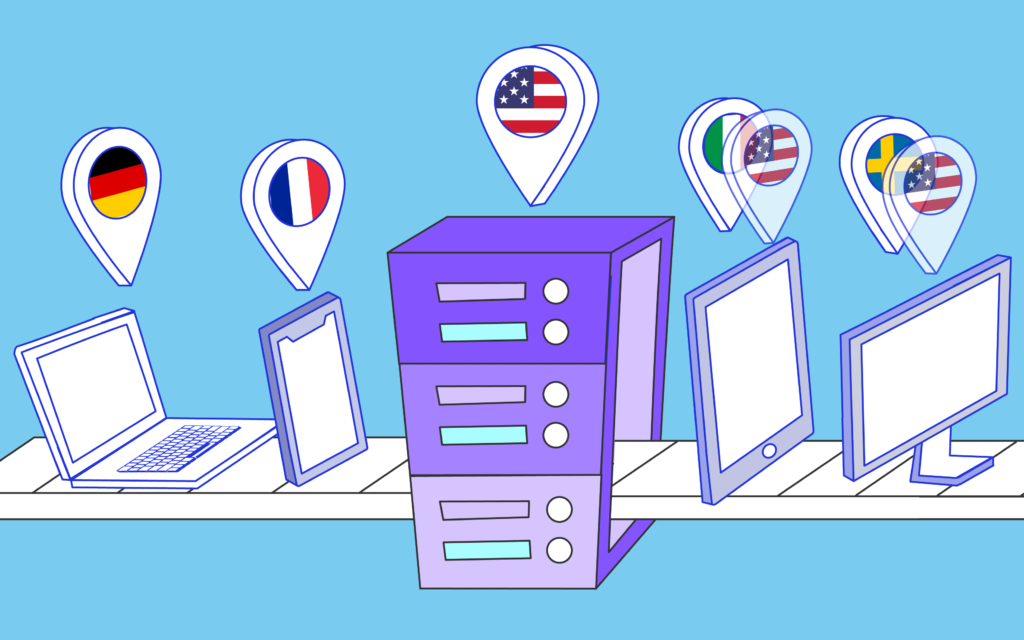Datacenter proxies are IP addresses provided by datacenters. They are not affiliated with an Internet Service Provider (ISP) or an Internet Service Offering (ISO). These proxies offer anonymity and serve as a buffer between the user and the internet, allowing users to hide their IP addresses and access websites without revealing their true location.

Difference between forward and reverse datacenter proxies
- Forward Datacenter Proxy:
- In a forward datacenter proxy setup, the client connects to the proxy server, and the proxy server forwards the client’s requests to the target server.
- This is the typical setup where the client initiates the connection to the proxy server, and the proxy server acts as an intermediary between the client and the target server.
- Forward proxies are commonly used for purposes like accessing restricted content, bypassing firewalls, and enhancing privacy.
- Reverse Datacenter Proxy:
- In a reverse datacenter proxy setup, the client connects directly to the target server, but the target server sees the proxy server as the client.
- This configuration is often used to improve security, load balancing, and caching for web servers. It allows multiple servers to appear as a single server to the outside world, enhancing scalability and resilience.
- Reverse proxies are commonly deployed in front of web servers to handle incoming requests, distribute traffic, and provide additional services like SSL termination, content caching, and DDoS protection.
How are the servers created ?
Datacenter proxy servers are typically created by setting up virtual or physical servers within a datacenter and installing proxy server software like Squid or Nginx. Networking configurations are then adjusted to enable communication between clients and target servers. Optional steps include implementing authentication mechanisms for access control and optimizing performance and security settings such as caching, load balancing, and SSL termination. Testing ensures proper functionality, and monitoring is established for ongoing performance evaluation. Scaling involves deploying multiple proxy servers and implementing load balancing for increased traffic handling and reliability. Regular maintenance and updates are performed to address security vulnerabilities and maintain optimal performance. Overall, the process involves server setup, software installation, network configuration, testing, monitoring, scaling, and maintenance to create functional and reliable datacenter proxy servers.
What companies can create them?
Datacenter proxies are sourced from auxiliary enterprises, including datacenters, hosting providers, and cloud hosting services. These entities establish and oversee a network of servers designed to provide top-tier proxy solutions tailored to specific needs. Additionally, they may extend services encompassing data management, storage, networking solutions, and hosting capabilities.
What are the types of datacenter proxies?
Datacenter proxies come in different types based on factors like IP address type, configuration, and usage. Here are some common types:
- Dedicated Datacenter Proxies: These proxies provide a single, dedicated IP address to a user. They offer greater reliability and are less likely to be blocked by websites compared to shared proxies.
- Shared Datacenter Proxies: Shared datacenter proxies allocate multiple users to the same IP address. While they are more affordable, they may be less reliable and more likely to be blocked by websites due to multiple users accessing the same IP.
- Static Datacenter Proxies: Static proxies maintain a consistent IP address, which remains the same each time you connect. They are suitable for tasks requiring stable connections, such as social media management or online account creation.
- Rotating Datacenter Proxies: Rotating proxies assign a pool of IP addresses that change with each request or after a set time interval. They offer higher anonymity and are ideal for tasks like web scraping and bypassing rate limits on websites.
- Residential Datacenter Proxies: Residential datacenter proxies simulate real residential IP addresses but are hosted in datacenters. They offer the benefits of residential proxies, such as lower detection rates, with the speed and affordability of datacenter proxies.
What are they used for?
They can serve various purposes across different industries and applications, thanks to their versatility and reliability. Here are some common uses:
- Web Scraping: Datacenter proxies are frequently employed for web scraping tasks, where automated bots extract data from websites. They allow businesses to gather valuable information for market research, competitive analysis, pricing intelligence, and other purposes without being blocked by websites.
- SEO Monitoring: SEO professionals use datacenter proxies to monitor search engine rankings, track keyword performance, analyze competitors’ websites, and gather data for SEO audits and reporting.
- Ad Verification: Advertisers and ad agencies use datacenter proxies to verify the placement and performance of online ads. By accessing websites from different IP addresses, they can ensure that ads are displayed correctly and reach the intended audience.
- Social Media Management: Social media marketers utilize datacenter proxies to manage multiple social media accounts and automate engagement activities such as posting, liking, commenting, and following/unfollowing users.
- Market Research: Datacenter proxies enable market researchers to collect data from various sources, including e-commerce websites, social media platforms, forums, and online databases. This data can be analyzed to gain insights into consumer behavior, trends, preferences, and sentiment.
- Brand Protection: Companies use datacenter proxies to monitor online mentions, reviews, and discussions about their brand, products, and services. This helps them identify and address potential reputation threats, trademark infringements, and counterfeit products.
- Price Monitoring: Retailers and e-commerce businesses use datacenter proxies to monitor competitor prices, track product availability, and analyze pricing trends. This information can be used to adjust pricing strategies, optimize product listings, and remain competitive in the market.
- Bypassing Geo-Restrictions: Datacenter proxies allow users to bypass geo-restrictions and access region-locked content on websites and streaming platforms. By routing their traffic through proxies located in different countries, users can overcome limitations based on their physical location.
Overall, this type of proxies play a crucial role in various business operations, enabling efficient data gathering, analysis, and online activity management while ensuring privacy, security, and compliance with website policies.